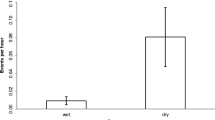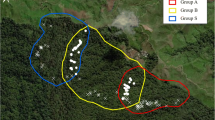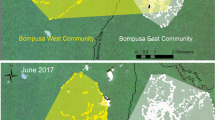Abstract
Socioecological theory suggests that between-group competition is an important factor affecting the nature of primate social relationships. Between-group encounters in macaques may involve female resource defense, male mate defense, and male resource defense. We observed between-group encounters in two groups (a forest group and a temple group) of bonnet macaques (Macaca radiata). We observed 102 encounters in 875 h of observation of the forest group (1.40 per 12-h day) and 58 encounters in 907 h of observation of the temple group (0.77 per 12-h day). Aggressive interactions between groups occurred in 32.4% and 29.3% of encounters in the forest and temple groups, respectively. Overall, we found little support for the female resource defense hypothesis. Females in both groups rarely participated aggressively in between-group encounters. We found support for the male mate defense hypothesis. For example, males of the forest group were more aggressive during encounters in the mating season than in the non-mating season. Males were also aggressive to females from their own group immediately following encounters. We also found partial support for the male resource defense hypothesis. Encounters in the forest group occurred in a feeding context more often than expected based on time budgets. Also, males in the temple group were more often aggressive in food-related encounters than in other encounters. The findings of this study suggest that socioecological models of primate social relationships need to distinguish male and female strategies during between-group encounters and integrate the resulting functional outcomes.




Similar content being viewed by others
References
Ali R (1981) The ecology and social behaviour of the Agastyamalai bonnet macaque (Macaca radiata diluta). Ph.D. dissertation, University of Bristol, Bristol, UK
Bauers K, Hearn J (1994) Patterns of paternity in relation to male social rank in the stumptailed macaque Macaca arctoides. Behaviour 129:149–176
Berard JD, Nurnberg P, Epplen JT, Schmidtke J (1994) Alternative reproductive tactics and reproductive success in free-ranging rhesus macaques. Behaviour 129:177–201
Bercovitch F, Nurnberg P (1997) Genetic determination of paternity and variation in male reproductive success in two populations of rhesus macaques. Electrophoresis 18:1701–1705
Borries C (1993) Ecology of female social relationships: hanuman langurs (Presbytis entellus) and the van Schaik model. Folia Primatol 61:21–30
Byrne RW, Whiten A, Henzi SP (1987) One-male groups and intergroup interactions of mountain baboons. Int J Primatol 8:615–633
Camperio Ciani A (1986) Intertroop agonistic behavior of a feral rhesus macaque troop ranging in town and forest areas in India. Aggress Behav 12:433–439
Cheney DL (1981) Intergroup encounters among free-ranging vervet monkeys. Folia Primatol 35:124–146
Cheney DL (1987) Interactions and relationships between groups. In: Smuts BB, Cheney DL, Seyfarth RM, Wrangham RW, Struhsaker TT (eds) Primate societies. University of Chicago Press, Chicago, Ill., pp 267–281
Cheney DL, Seyfarth RM (1977) Behavior of adult and immature male baboons during inter-group encounters. Nature 269:404–406
Cheney DL, Seyfarth RM (1987) The influence of intergroup competition on the survival and reproduction of female vervet monkeys. Behav Ecol Sociobiol 21:375–386
Cheney DL, Seyfarth RM, Andelman SJ, Lee PC (1988) Reproductive success in vervet monkeys. In: Clutton-Brock TH (ed) Reproductive success. University of Chicago Press, Chicago, Ill., pp 384–402
Clarke AS, Mason WA (1988) Differences among three macaque species in responsiveness to an observer. Int J Primatol 9:347–364
Collins DA, Busse CD, Goodall J (1984) Infanticide in two populations of savanna baboons. In: Hrdy SB, Hausfater G (eds) Infanticide: comparative and evolutionary perspectives. Aldine de Gruyter, New York, pp 193–215
Cooper MA, Bernstein IS (2000) Social grooming in assamese macaques (Macaca assamensis). Am J Primatol 50:77–85
Cowlishaw G (1995) Behavioral patterns in baboon group encounters: the role of resource competition and male reproductive strategies. Behaviour 132:75–86
Deag JM (1973) Intergroup encounters in the wild barbary macaque (Macaca sylvanus L.). In: Michael RP, Crook, JH (eds) Comparative ecology of behavior of primates. Academic, London, pp 315–373
Dittus WPJ (1986) Sex differences in fitness following a group take-over among toque macaques: testing models of social evolution. Behav Ecol Sociobiol 19:257–266
Emlen ST, Oring LW (1977) Ecology, sexual selection, and the evolution of mating systems. Science 197:215–223
Fashing PJ (2001) Male and female strategies during intergroup encounters in guerezas (Colobus guereza): evidence for resource defense mediated through males and a comparison with other primates. Behav Ecol Sociobiol 50:219–230
Gompper ME (1996) Foraging costs and benefits of coati (Nasua narica) sociality and asociality. Behav Ecol 7:254–263
Harrison MJS (1983) Territorial behavior in the green monkey, Cercopithecus sabaeus: seasonal defense of local food supplies. Behav Ecol Sociobiol 12:85–94
Hausfater G (1972) Intergroup behavior of free-ranging rhesus monkeys (Macaca mulatta). Folia Primatol 18:78–107
Heinsohn R (1997) Group territoriality in two populations of African lions. Anim Behav 53:1143–1147
Heinsohn R, Packer C (1995) Complex cooperative strategies in group-territorial African lions. Science 269:1260–1262
Hood LC (1994) Infanticide among ringtailed lemurs (Lemur catta) at Berenty reserve, Madagascar. Am J Primatol 33:65–9
Isbell LA (1991) Contest and scramble competition: patterns of female aggression and ranging behavior among primates. Behav Ecol 2:143–155
Keane B, Dittus W, Melnick D (1997) Paternity assessment in wild groups of toque macaques Macaca sinica at Polonnaruwa Sri Lanka using molecular markers. Mol Ecol 6:267–282
Kinnaird MF (1992) Variable resource defense by the Tana River crested mangabey. Behav Ecol Sociobiol 31:115–122
Kumar A, Kurup GU (1985) Inter-troop interactions in the lion-tailed macaque, Macaca silenus. In: Heltne PG (ed) The lion-tailed macaque: status and conservation. Wiley-Liss, New York, pp 91–107
Kummer H (1968) Social organization of hamadryas baboons. Chicago University Press, Chicago, Ill.
Kuruvilla GP (1980) Ecology of the bonnet macaque (Macaca radiata) with special reference to feeding habits. J Bombay Nat Hist Soc 75:976–988
Lindburg DG (1969) Rhesus monkeys: mating season mobility of adult males. Science 166:1176–1178
Lindburg DG (1971) The rhesus monkey in North India: An ecological and behavior study. In: Rosenblum LA (ed) Primate behavior: developments in field and laboratory research, vol. 2. Academic, New York, pp 1–106
Manson JH, Wrangham RW (1991) Intergroup aggression in chimpanzees and humans. Curr Anthropol 32:369–390
Matsumura S (1998) Relaxed dominance relations among female moor macaques (Macaca maurus) in their natural habitat, South Sulawesi, Indonesia. Folia Primatol 69:346–356
Mehlman PT, Parkhill RS (1988) Intergroup interactions in wild barbary macaques (Macaca sylvanus), Ghomaran Rif Mountains, Morocco. Am J Primatol 15:31–44
Mills MGL (1982) Factors affecting group size and territory size of the brown hyaena, Hyaena brunnea, in the southern Kalahari. J Zool 198:39–51
Mills MGL (1989) The comparative behavioral ecology of hyaenas. In: Gittleman JL (ed) Carnivore behavior, ecology, and evolution. Cornell University Press, Ithaca, N.Y., pp 125–142
Moore J (1984) Female transfer in primates. Int J Primatol 5:537–589
Noe R, van Schaik CP, van Hooff JARAM (1991) The market effect: an explanation for pay-off asymmetries among collaborating animals. Ethology 87:97–118
Nunn CL (2000) Collective benefits, free-riders, and male extra-group conflict. In: Kappeler P (ed) Primate males: causes and consequences of variation in group composition. Cambridge University Press, Cambridge, pp 192–204
Okamoto K, Matsumura S (2002) Intergroup encounters in wild moor macaques (Macaca maurus). Primates 43:119–125
Packer C (1979) Inter-troop transfer and inbreeding avoidance in Papio anubis. Anim Behav 27:1–36
Packer C, Pusey AE (1982) Asymmetric contests in social mammals: respect, manipulation, and age-specific aspects. In: Greenwood PJ, Harvey PH, Slatkin M (eds) Evolution: essays in honor of John Maynard Smith. Cambridge University Press, Cambridge, pp 173–185
Packer C, Scheel D, Pusey AE (1990) Why lions form groups: food is not enough. Am Nat 136:1–19
Paul A, Kuester J, Arnemann J (1996) The sociobiology of male–infant interactions in Barbary macaques, Macaca sylvanus. Anim Behav 51:155–170
Perry S (1996) Intergroup encounters in wild white-faced capuchins (Cebus capucinus). Int J Primatol 17:309–330
Pusey AE, Packer C (1987) Dispersal and philopatry. In: Smuts BB, Cheney DL, Seyfarth RM, Wrangham RW, Struhsaker TT (eds) Primate societies. University of Chicago Press, Chicago, Ill., pp 250–66
Robinson JG (1988) Group size in wedge-capped capuchin monkeys Cebus olivaceus and the reproductive success of males and females. Behav Ecol Sociobiol 23:187–97
Rubenstein DI (1986) Ecology and sociality in horses and zebras. In: Rubenstein DI, Wrangham RW (eds) Ecology and social evolution: birds and mammals. Princeton University Press, Princeton, N.J., pp 282–303
Ruiter J de, van Hooff J (1993) Male dominance rank and reproductive success in primate groups. Primates 34:513–523
Saito C, Sato S, Suzuki S, Sugiura H, Agetsuma N, Takahata Y, Sasaki C, Takahashi H, Tanaka T, Yamagiwa J (1998) Aggressive intergroup encounters in two populations of Japanese macaques (Macaca fuscata). Primates 39:303–312
Schaik CP van (1985) The socio-ecology of Sumatran long-tailed macaques (Macaca fascicularis), I. Costs and benefits of group living. PhD dissertation, University of Utrecht, The Netherlands
Schaik CP van (1989) The ecology of social relationships amongst female primates. In: Standen V, Foley RA (eds) Comparative socioecology: the behavioral ecology of humans and other mammals. Blackwell, Oxford, pp 195–218
Schaik CP van (1996) Social evolution in primates: the role of ecological factors and male behaviour. Proc Br Acad 88:9–31
Schaik CP van , Assink PR, Salapsky N (1992) Territorial behavior in Southeast Asian langurs: resource defense or mate defense? Am J Primatol 26:233–242
Sekulic R (1982) The function of howling in red howler monkeys (Alouatta seniculus). Behaviour 81:38–54
Sicotte P (1993) Inter-group encounters and female transfer in mountain gorillas: influence of group composition on male behavior. Am J Primatol 30:21–36
Silk JB (1994) Social relationships of male bonnet macaques: male bonding in a matrilineal society. Behaviour 130:271–291
Silk JB, Samuels A, Rodman PS (1981) Hierarchical organization of female Macaca radiata in captivity. Primates 22:84–95
Singh M (1999) Studies on the ecology, adaptation and evolution of sociality in non-human primates of south India. Technical report for the Ministry of Environment and Forests. Government of India, pp 234
Singh M, Singh M, Kumar MA, Kumara HN, D’Souza L (1997a) Distribution and research potential of non-human primates in the Aliyar-Valparai sector of Indira Gandhi Wildlife Sanctuary, Tamil Nadu, India. Trop Biodivers 4:197–208
Singh ME, Singh MR, Kumara HN, Kumar MA, D’Souza L (1997b) Inter- and intra-specific associations of non-human primates in Anaimalai Hills, South India. Mammalia 61:17–28
Singh M, Singh M, Sharma AK, Krishna BA (2003) Methodological considerations in measurement of dominance in primates. Curr Sci 84:709–713
Singh SD (1969) Urban monkeys. Sci Am 221:108–115
Soltis J, Thomsen R, Takenaka O (2001) The interaction of male and female reproductive strategies and paternity in wild Japanese macaques (Macaca fuscata). Anim Behav 62:485–94
Sommer V (1994) Infanticide among the langurs of Jodhpur: testing the sexual selection hypothesis with a long-term record. In: Parmigiani S, vom Saal FS (eds) Infanticide and parental care. Harwood Academic, London, pp 155–198
Southwick CH (1962) Patterns of intergroup social behavior in primates, with special reference to rhesus and howling monkeys. Ann NY Acad Sci 102:436–54
Southwick CH, Siddiqi MR, Farooqui MY, Pal BC (1976) Effects of artificial feeding on aggressive behavior of rhesus monkeys in India. Anim Behav 24:11–15
Sprague DS (1991) Mating by nontroop males among the Japanese macaques of Yakushima Island. Folia Primatol 57:156–158
Stanford CB (1991) Social dynamics of intergroup encounters in the capped langur (Presbytis pileata). Am J Primatol 25:35–47
Steenbeek R (1999) Tenure related changes in wild Thomas’s langurs. I. Between-group interactions. Behaviour 136:595–625
Sterck EHM (1997) Determinants of female dispersal in Thomas’s langurs. Am J Primatol 42:179–198
Sterck EHM, Watts DP, van Schaik CP (1997) The evolution of female social relationships in nonhuman primates. Behav Ecol Sociobiol 41:291–309
Sugiura H, Saito C, Sato S, Agetsuma N, Takahashi H, Tanaka T, Furuichi T, Takahata Y (2000) Variation in intergroup encounters in two populations of Japanese macaques. Int J Primatol 21:519–35
Sugiyama Y (1971) Characteristics of the social life of bonnet macaques (Macaca radiata). Primates 12:247–66
Tarara EB (1987) Infanticide in a chacma baboon troop. Primates 28:267–270
Thierry B (2000) Covariation of conflict management patterns across macaque species. In: Aureli F, de Waal FBM (eds) Natural conflict resolution. University of California, Berkeley, Calif., pp 106–128
Trivers RL (1972) Parental investment and sexual selection. In: Campbell B (ed) Sexual selection and the decent of man. Aldine, Chicago, Ill., pp 136–179
Vessey SH (1968) Interactions between free-ranging groups of rhesus monkeys. Folia Primatol 8:228–239
Watts DP (1989) Infanticide in mountain gorillas: new cases and a review of evidence. Ethology 81:1–18
Wrangham RW (1980) An ecological model of female-bonded primate groups. Behaviour 75:262–300
Zar JH (1999) Biostatistical analysis, 4th edn. Prentice Hall, Upper Saddle River, N.J., pp 505–06
Acknowledgements
We thank the Tamil Nadu Forest Department for permission to conduct research in the Anaimalai Hills, and the management of Waterfall Tea Estates for logistical support. We thank the U.S. National Science Foundation (grant no.: INT-9901439) for funding this research and the American Institute of Indian Studies for helping to obtain a research visa. We are grateful to M.A. Anand, M.S. Chaitra, H.N. Kumara, A.K. Sharma and H.S. Sushma for their assistance in the field. We thank I. Bernstein, E. Johnson, and three anonymous reviewers for comments on an earlier version of the manuscript. This research project complied with Indian Law and was approved by the University of Georgia Institutional Animal Care and Use Committee.
Author information
Authors and Affiliations
Corresponding author
Additional information
Communicated by T. Czeschlik
Rights and permissions
About this article
Cite this article
Cooper, M.A., Aureli, F. & Singh, M. Between-group encounters among bonnet macaques (Macaca radiata). Behav Ecol Sociobiol 56, 217–227 (2004). https://doi.org/10.1007/s00265-004-0779-4
Received:
Revised:
Accepted:
Published:
Issue Date:
DOI: https://doi.org/10.1007/s00265-004-0779-4




